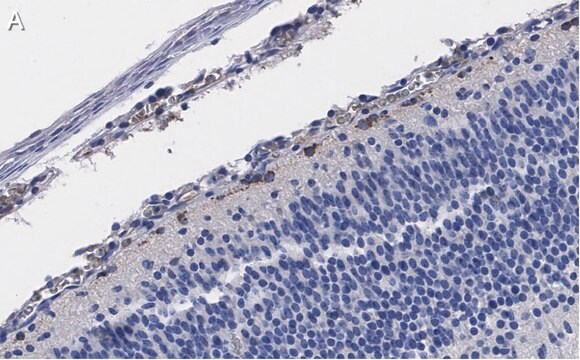おすすめの製品
由来生物
mouse
結合体
unconjugated
抗体製品の状態
ascites fluid
抗体製品タイプ
primary antibodies
クローン
1H4, monoclonal
分子量
36 kDa
化学種の反応性
human
テクニック
direct ELISA: 1:10,000
flow cytometry: 1:200-1:400
immunohistochemistry: 1:200-1:1,000
western blot: 1:500-1:2,000
アイソタイプ
IgG1
NCBIアクセッション番号
UniProtアクセッション番号
輸送温度
wet ice
保管温度
−20°C
ターゲットの翻訳後修飾
unmodified
遺伝子情報
human ... ApoE(348)
詳細
Apolipoprotein E (ApoE) belongs to a group of proteins that bind reversibly with lipoproteins. Significant quantities of ApoE are produced in liver and brain and to some extent in almost every organ. ApoE is an important constituent of all plasma lipoproteins. ApoE exists in three major isoforms; E2, E3, and E4, which differ from one another by a single amino-acid substitution. Compared with E3 and E4, E2 exhibits the lowest receptor binding affinity. E2 allele carriers have significantly lower levels of total cholesterol, low-density lipoprotein cholesterol, and non-high-density lipoprotein cholesterol, as well as increased ApoE levels. The gene encoding this protein is localized on human chromosome 19q13.32.
免疫原
Purified recombinant fragment of human ApoE expressed in E.coli.
Mouse monoclonal antibody raised against ApoE
Mouse monoclonal antibody raised against ApoE
生物化学的/生理学的作用
In addition to facilitating solubilization of lipids, apolipoproteins help to maintain the structural integrity of lipoproteins, serve as ligands for lipoprotein receptors, and regulate the activity of enzymes involved in lipid metabolism. Apolipoprotein E (ApoE) plays an important role in lipid metabolism. It′s interaction with specific ApoE receptor enables uptake of chylomicron remnants by liver cells, which is an essential step during normal lipid metabolism. It also binds with the LDL receptor (Apo B/E). Defects in ApoE are a cause of hyperlipoproteinemia type III.
物理的形状
Ascitic fluid containing 0.03% sodium azide.
免責事項
Unless otherwise stated in our catalog or other company documentation accompanying the product(s), our products are intended for research use only and are not to be used for any other purpose, which includes but is not limited to, unauthorized commercial uses, in vitro diagnostic uses, ex vivo or in vivo therapeutic uses or any type of consumption or application to humans or animals.
適切な製品が見つかりませんか。
製品選択ツール.をお試しください
保管分類コード
10 - Combustible liquids
WGK
WGK 3
引火点(°F)
Not applicable
引火点(℃)
Not applicable
適用法令
試験研究用途を考慮した関連法令を主に挙げております。化学物質以外については、一部の情報のみ提供しています。 製品を安全かつ合法的に使用することは、使用者の義務です。最新情報により修正される場合があります。WEBの反映には時間を要することがあるため、適宜SDSをご参照ください。
Jan Code
SAB5300354-100UL:
試験成績書(COA)
製品のロット番号・バッチ番号を入力して、試験成績書(COA) を検索できます。ロット番号・バッチ番号は、製品ラベルに「Lot」または「Batch」に続いて記載されています。
Anja Beierfuß et al.
PloS one, 12(11), e0187564-e0187564 (2017-11-04)
Intervertebral disc (IVD) degeneration that accelerates the loss of disc structural and functional integrities is recognized as one of the major factors of chronic back pain. Cardiovascular risk factors, such as deficits of apolipoproteins that elevate the levels of cholesterol
Michael C Phillips
IUBMB life, 66(9), 616-623 (2014-10-21)
Apolipoprotein (apo) E is a 299-residue protein which functions as a key regulator of plasma lipid levels. Human apoE exists as three common isoforms and the parent form, apoE3, operates optimally in promoting clearance of triglyceride (TG)-rich lipoproteins and is
R W Mahley et al.
Journal of lipid research, 40(11), 1933-1949 (1999-12-20)
Type III hyperlipoproteinemia (HLP) is a genetic disorder characterized by accumulation of remnant lipoproteins in the plasma and development of premature atherosclerosis. Although receptor binding-defective forms of apolipoprotein (apo) E are the common denominator in this disorder, a number of
Martine Prévost et al.
Proteins, 55(4), 874-884 (2004-05-18)
Apolipoprotein E (apoE) is an important protein involved in lipid metabolism due to its interaction with members of the low-density lipoprotein receptor (LDLR) family. To further understand the molecular basis for this receptor-binding activity, an apoE fragment containing the receptor
Joris Deelen et al.
Aging cell, 10(4), 686-698 (2011-03-23)
By studying the loci that contribute to human longevity, we aim to identify mechanisms that contribute to healthy aging. To identify such loci, we performed a genome-wide association study (GWAS) comparing 403 unrelated nonagenarians from long-living families included in the
ライフサイエンス、有機合成、材料科学、クロマトグラフィー、分析など、あらゆる分野の研究に経験のあるメンバーがおります。.
製品に関するお問い合わせはこちら(テクニカルサービス)







